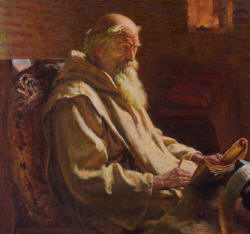
The Historical Works Of Venerable Bede
CHAPTER VIII
OF THE SITUATION OF BETHLEHEM, AND THE CHURCH WHERE OUR LORD WAS BORN; AND OF THE TOMBS OF DAVID AND HIERONYMUS, AND THE THREE SHEPHERDS
BETHLEHEM is six miles distant from Jerusalem, towards the south. It is situated on a narrow ridge, surrounded on every side by valleys: it is a mile long from west to east, and has a low wall built along the edge of the brow of the hill. At its eastern angle there is a sort of natural cave, the outer part of which is said to have been the place of our Lord’s birth; the inside is called “Our Lord’s Manger.” The whole of this cave is covered within with beautiful marble, over the place where especially our Lord is said to have been born. It has above it the great church of St. Mary. Near the wall is a hollow stone, which received back from the wall the first water in which our Lord’s body was washed, when it was thrown away, and still retains the same. If by any accident or service it has been emptied, it nevertheless becomes again, in a short time, as full as before. To the north of Bethlehem, in a neighbouring valley, is the tomb of David, in the middle of the church, covered with a low stone, and with a lamp placed above it. In a church which stands in an adjoining valley, to the south, is the tomb of Jerome. Moreover, on the eastern side, in the tower of Ader, that is, of the Flock, at the distance of a thousand paces from the city, is a church, containing monuments of the three shepherds who were present at our Lord’s birth. I have stated these facts on the authority of Bishop Archulph. But Erras writes in plain terms, that David was buried in Jerusalem, in the King’s-way, which leads from Ælia to Cedron; that Bethlehem is to the east of it, and to the west is the tomb of Rachel, having her name inscribed upon it even to this day.
Copyright ©1999-2023 Wildfire Fellowship, Inc all rights reserved

 Keep Site Running
Keep Site Running